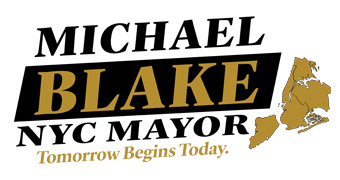Blake's Environmental Justice Plan
Environmental Justice Plan:
Vision:
Michael Blake believes that environmental justice must be central to New York City’s future. As the son of Jamaican immigrants and a Bronx native shaped by faith and service, Blake understands that climate justice is racial justice, economic justice, and public health justice. For too long, low-income and frontline communities, especially Black, Latino, immigrant, and NYCHA residents have endured the burden of pollution, heat, flooding, poor air quality, and policy neglect. This plan is about correcting environmental wrongs and preparing New York City for a sustainable, resilient, and inclusive future. Whether it’s through clean air, safe water, green infrastructure, or climate-safe housing, environmental justice must be a foundation, not an afterthought in everything the city does.
GROUNDING THE CRISIS IN DATA
New York City faces an escalating environmental crisis with deeply unequal consequences. It is the third-most climate-vulnerable city in the United States, with over 1.3 million residents currently living in flood-prone zones, a number expected to rise. Black and Latino children are twice as likely to be hospitalized for asthma, largely due to disproportionate exposure to air pollution and proximity to highways, waste facilities, and industrial zones. In neighborhoods like the South Bronx, North Brooklyn, and Southeast Queens, communities report some of the highest rates of environmental illness, infrastructure decay, and climate risk. Yet despite these realities, climate adaptation investments and regulatory enforcement remain uneven. These disparities are not accidental, they are the legacy of environmental racism, policy neglect, and decades of disinvestment. Addressing the climate crisis in New York City means reckoning with these historic injustices and prioritizing the communities that have been most harmed.
1) Climate Resilience and Public Infrastructure
Key Policy Actions:
- Launch a $1B Climate Resilience Fund to finance neighborhood cooling centers, emergency microgrids, coastal protections, and home retrofits in flood-prone neighborhoods. This fund will support local job creation and focus on communities hit hardest by past storms and heatwaves.
- Establish a Citywide Climate Equity Council in each borough to ensure frontline communities have direct input in the design, implementation, and oversight of resilience projects. These councils will include local residents, climate scientists, small business owners, and youth.
- Expand Green Roofs and Cool Pavement installations across NYCHA and public-school buildings to reduce urban heat, improve insulation, and provide green jobs through union-led apprenticeships.
- Mandate nature-based solutions such as wetlands restoration, bioswales, tree canopy expansion, and permeable sidewalks in all city infrastructure projects. These solutions reduce stormwater runoff, mitigate flood risk, and restore local ecosystems.
2) Green and Just Land Use
Key Policy Actions:
- Ban new residential development in FEMA-designated flood zones unless certified for climate resilience. New York cannot continue placing vulnerable residents in known danger zones.
- Replace Area Median Income (AMI) with Local Median Income (LMI) in housing affordability definitions to ensure that homes built in climate-vulnerable areas are actually accessible to local residents, especially low-income New Yorkers.
- Fast-track zoning and approvals for renewable energy installations like rooftop solar, wind turbines, and battery storage on all city-owned properties, especially in outer boroughs.
- Implement Mitchell-Lama 2.0, requiring all new deeply affordable housing developments to meet passive house standards, be built with sustainable materials, and be located in areas with low environmental risk.
3) Waste Justice and Sanitation Reform
Key Policy Actions:
- Accelerate citywide containerization of waste to eliminate sidewalk trash piles and combat rising rat complaints. Ensure equitable bin distribution, upgrade sanitation fleets, and support smaller buildings with design flexibility.
- Expand community composting and borough-wide organic waste hubs through legislation like Intro 696, in partnership with GrowNYC, community gardens, and local organizations.
- Ban land-spreading of anaerobic digestate (sewage sludge and food scraps) due to toxic “forever chemicals” and soil contamination risks. Invest instead in safe, clean compost processing and use it for parks and gardens.
- Establish a Zero Waste to Landfill timeline for NYC, requiring phased diversion targets and funding waste diversion efforts in schools, city buildings, and large commercial enterprises.
4) Clean Energy and Air Pollution
Key Policy Actions:
- Enforce and expand Local Law 97 to hold large building owners accountable for reducing emissions. Ensure public transparency of compliance and provide grants for retrofits in lower-income co-ops and multifamily dwellings.
- Support Intro 1180, capping the use of renewable energy credits so building emissions reductions are real and measurable, not just paperwork offsets.
- Ban fossil fuel hookups in all new construction by 2027, with city subsidies for all-electric retrofits in existing homes and small businesses.
- Electrify all public buildings and schools by 2035, creating public-sector demand for clean energy jobs and reducing dependence on natural gas and fuel oil.
5) Wildlife, Biodiversity, and Humane Urbanism
Key Policy Actions:
- Pass “Lights Out” legislation and Intro 1073 to protect migratory birds from fatal building collisions and require retrofitting with bird-safe glass.
- Require bird-friendly markers and materials on all new MTA bus shelters and other transparent structures citywide.
- Ban rat poisons citywide and expand humane rodent control programs that use contraception and environmental design rather than toxic chemicals.
- Shut down NYC’s live-animal slaughter markets, citing zoonotic risk, community safety, and public health, while supporting a state-level ban on importing trophies from endangered “Big Five” species.
6) Parks, Green Space, and Environmental Equity
Key Policy Actions:
- Dedicate 1% of NYC’s budget to the Parks Department, with a focus on underfunded community parks and “Forever Wild” natural areas that reduce heat and flooding.
- Ban installation of artificial turf in parks and playgrounds, citing safety, heat retention, and microplastic pollution risks. Invest in grass-based athletic fields and green space preservation.
- Launch a Tree Equity initiative to achieve 30% canopy cover in every neighborhood by 2035, prioritizing communities with the least green space.
- Create borough-based Green Space Equity Councils to advise on new park locations, tree planting, and public space design rooted in community needs.
7) Transportation and Air Quality
Key Policy Actions:
- Expand congestion pricing with equity-based exemptions and reinvest revenue into accessible public transit for outer borough and low-income residents.
- Mandate all public fleets (school buses, ferries, sanitation trucks) transition to zero-emission vehicles by 2035.
- Retrofit freight hubs, ports, and bus depots with electrification infrastructure to reduce diesel emissions and air pollution in adjacent neighborhoods.
- Support statewide legislation requiring all publicly funded ferries and transit systems to adopt zero-emission technology by 2030.
8) Public Health and Environmental Toxins
Key Policy Actions:
- Create a Health and Environment Equity Task Force to study asthma clusters, lead exposure, mold in NYCHA, and environmental illness disparities by ZIP code.
- Mandate lead and asbestos testing and remediation in all public housing, shelters, and schools, prioritizing buildings serving children and seniors.
- Ban use of toxic pesticides and chemical lawn treatments in city-owned parks and playgrounds.
- Launch a Public Health Resilience Corps to provide education, prevention, and support for residents living in high-risk environmental zones.
9) Accountability and Community Power
Key Policy Actions:
- Create an Office of Environmental Justice and Resilience, reporting directly to the Mayor, with authority to coordinate citywide climate and equity policies.
- Publish a Climate Equity Dashboard to track investments, pollution reduction, and program outcomes by race, income, and geography.
- Establish a NYC Youth Climate Corps, hiring 5,000 young people to work in restoration, renewable energy, urban agriculture, and community outreach.
- Fund environmental justice education in K-12 schools, senior centers, public libraries, and workforce programs.
10) Education, Workforce, and Innovation for a Green Future
Key Policy Actions:
- Establish a Green Jobs Academy in every borough, in partnership with CUNY, labor unions, and community-based organizations. These academies will train residents, especially youth, justice-impacted individuals, and public housing residents for careers in renewable energy, sustainable construction, environmental monitoring, and green infrastructure maintenance.
- Integrate climate justice and sustainability education into all K–12 public schools by working with the Department of Education and community educators to embed environmental literacy into science, civics, and health classes. Students will learn how local environmental challenges affect their communities and how they can become stewards and leaders in solving them.
- Fund “Green STEAM” (Science, Technology, Engineering, Arts, and Math) Labs in public schools and libraries, prioritizing underserved neighborhoods. These labs will provide access to project-based learning in areas like solar technology, environmental engineering, clean coding, and ecological design, equipping the next generation with the tools to innovate and adapt.
- Create a Climate Innovation Fellowship Program that places 200 recent graduates, climate researchers, and civic technologists in City agencies and nonprofits. Fellows will work on high-impact projects related to data transparency, urban greening, pollution mapping, and climate adaptation.
- Launch a Climate Entrepreneurs Fund, providing microgrants and mentorship to low-income New Yorkers starting sustainable small businesses, such as e-bike courier services, rain garden installation, or upcycled fashion enterprises. Innovation should not be limited to tech giants; it must include community-led, culturally rooted environmental solutions.
How We Move Forward
Michael Blake will appoint a Deputy Mayor for Environmental Justice and Resilience to lead this work across all city agencies. This role will ensure climate adaptation, environmental health, sustainability, and community protection are not siloed, but embedded in housing, transportation, education, sanitation, and public safety. Our climate strategy must be one of justice, innovation, and bold action rooted in community.



